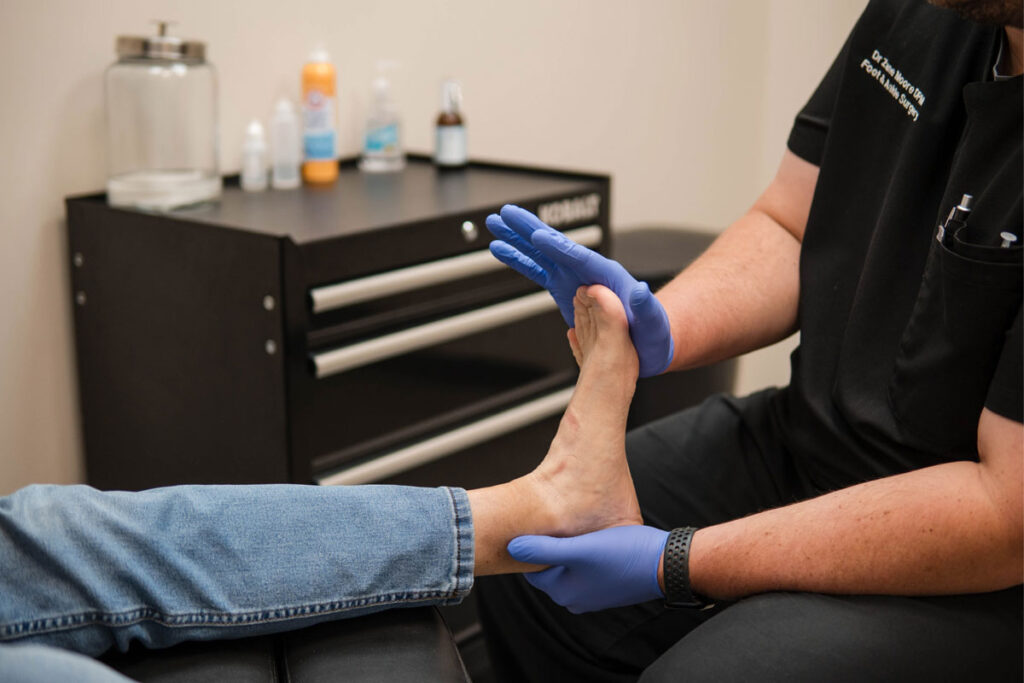Taking care of your feet and ankles is essential to overall health, mobility, and quality of life. Neglecting proper care can lead to painful issues, including plantar fasciitis, ankle sprains, and bunions. In this guide, we provide a list of the top tips for maintaining healthy feet and ankles to help you maintain strength, flexibility, and comfort.
Maintain Good Hygiene Daily
Keeping your feet clean and dry is one of the most critical steps in preventing infections like athlete’s foot. Wash your feet daily with warm water and mild soap, and dry them thoroughly, especially between your toes. Moisturize regularly to prevent dry, cracked skin but avoid applying lotion between the toes to prevent bacterial growth.
Also, inspect your feet for cuts, blisters, or signs of infection. Early detection of these issues can prevent complications and speed up recovery.
Wear Proper Footwear for Different Activities
Shoes that fit well and provide proper support are vital to foot and ankle health. Choose shoes that offer:
- Arch support
- Cushioning
- A wide toe box to prevent pressure on your toes
For athletic activities, wear sport-specific shoes designed to handle the demands of the activity. For example, running shoes offer different support compared to hiking boots or basketball shoes. If you stand for long periods, invest in supportive, cushioned footwear to prevent fatigue and soreness.
Avoid high heels and flip-flops for extended periods, as these can increase the risk of injury, imbalance, and long-term foot problems.
Stretch and Strengthen Regularly
Strong and flexible muscles support healthy joints and reduce the risk of injury. Incorporate stretching exercises into your daily routine to improve flexibility and range of motion. Beneficial exercises include:
- Calf stretches: Loosen up the Achilles tendon and reduce heel pain.
- Toe stretches: Improve toe flexibility and prevent cramps.
- Heel raises: Strengthen the calves and the arch of your feet.
Regular stretching can help you recover faster from physical activity and reduce the risk of plantar fasciitis and Achilles tendonitis.
Keep an Eye on Your Weight and Nutrition
Excess weight puts additional pressure on your feet and ankles, increasing the risk of heel pain, flat feet, and arthritis. Maintaining a healthy weight through balanced nutrition and regular exercises can reduce strain and prevent overuse injuries.
Consuming calcium- and vitamin D-rich foods, such as dairy products, leafy greens, and fish, promotes bone strength, while proper hydration helps prevent muscle cramps.
Trim Toenails Properly and Treat Fungal Infections
Improper nail care can lead to painful ingrown toenails and infections. Trim your toenails straight across and avoid cutting them too short to prevent the nails from growing into the surrounding skin.
If you experience thick, discolored, or brittle nails, you may have a fungal infection. Treat it early using antifungal creams or sprays, and if symptoms persist, consult a podiatrist.
Protect Against Injury During Physical Activities
Foot and ankle injuries can occur during exercise, walking, or even day-to-day tasks. You can reduce the risk by:
- Warming up before exercise to loosen muscles.
- Wearing proper orthotics or insoles for added support.
- Using ankle braces if you have a history of ankle sprains.
If you feel pain or discomfort during activity, stop and rest. Ignoring early signs of pain can lead to more severe issues, including ligament or tendon injuries.
Address Foot Pain Early
Ignoring foot or ankle pain can lead to long-term damage and more serious conditions. Persistent pain can signal underlying issues such as plantar fasciitis, tendonitis, or stress fractures.
Home remedies, such as rest, ice, compression, and elevation (RICE), can help with minor injuries. However, if the pain persists, consult a podiatrist for a proper diagnosis and treatment.
Stay Hydrated and Monitor Circulation
Proper hydration is key to muscle function and reducing the risk of cramping. For individuals with diabetes or peripheral vascular disease, monitoring circulation in the feet is essential. Common signs of poor circulation include cold feet, numbness, and slow-healing wounds. Engaging in regular physical activity, wearing compression socks, and elevating your legs can help improve blood flow.
Managing Chronic Conditions Like Diabetes
Diabetes and other chronic conditions can cause nerve damage (neuropathy), making it difficult to detect injuries or infections. If you have diabetes, perform daily foot inspections to check for sores, blisters, or changes in skin color. Diabetic foot ulcers can develop quickly and require immediate attention.
Partnering with a podiatrist ensures you have a personalized foot care plan, including routine checkups to prevent complications.
Regular Checkups with a Podiatrist Are Essential
Even if you don’t have any foot pain, regular visits to a podiatrist can help prevent issues. A professional can detect problems early, provide custom orthotics for support, and offer advice on injury prevention. Many foot conditions can be managed effectively with early intervention.

FAQ: Maintaining Foot and Ankle Health
How often should I replace my shoes?
Athletic shoes should be replaced every 300-500 miles of use or once you notice decreased support. Casual shoes should be replaced if they feel uncomfortable or show visible signs of wear.
How do I know if I need orthotics?
If you experience foot pain, flat feet, or frequent ankle sprains, a podiatrist can assess whether custom orthotics are necessary to provide support and realignment.
Can foot pain affect my overall health?
Yes. Foot pain can lead to changes in posture, reduced mobility, and secondary pain in areas like the knees, hips, and lower back.
Take the Next Step for Healthy Feet
At Central Arkansas Foot and Ankle Specialists in Conway, Arkansas, we provide comprehensive care to ensure you stay on your feet and pain-free. Our full-service podiatry clinic offers expert advice, custom orthotics, and treatment plans for all types of foot and ankle concerns. Contact us at (501) 483-0900 to schedule an appointment and maintain long-term foot health.


Recent Comments